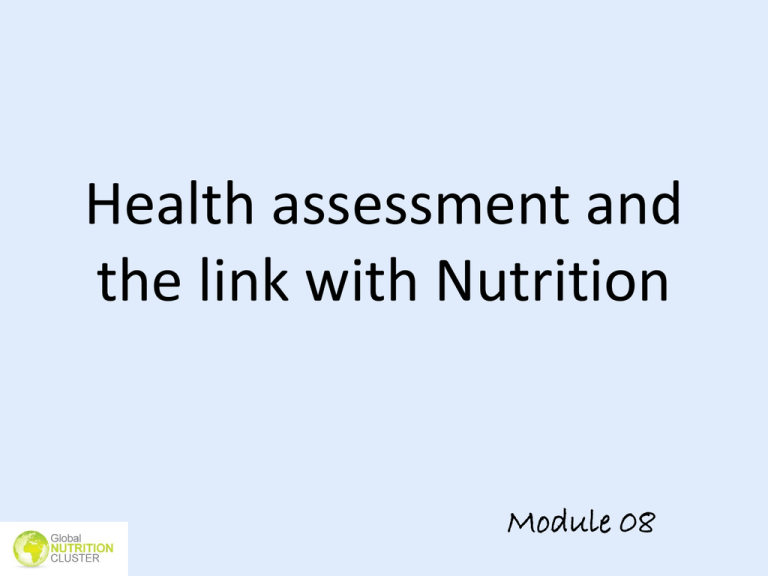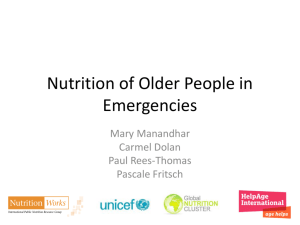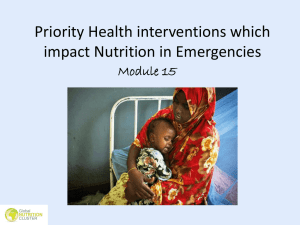
Health assessment and
the link with Nutrition
Module 08
Learning Objectives
• Understand the important links between Health
and Nutrition
• Understand the importance of joint or
coordinated Health and Nutrition assessments
• Understand the importance of coordination in
humanitarian assessment generally
• Be aware of the different types of Health
assessments that are required during an
emergency and the links with Nutrition
• Be able to plan and participate in a Health
assessment which includes Nutrition
1
2
Conceptual framework on causes of undernutrition
Undernutrition
Immediate
causes
Underlying
causes
Basic causes
Inadequate food
Disease
intake
Household
food
insecurity
Poor social
and care
practices
Inadequat
ePublic
Health
Formal and informal infrastructure/
political ideology/resources
1
3
The link between Undernutrition and Health
WHO estimates
that
undernutrition
contributes to
more than one
third of all child
deaths 0-59
months
1
4
Link between Undernutrition and Health
•
•
•
The major causes of excess morbidity and
mortality in emergencies are: acute
respiratory infections, diarrhoeal diseases,
malaria (where prevalent), measles and
undernutrition
In complex emergencies or in earthquakes,
violent trauma/physical injury is a major
cause of morbidity and mortality
Emergency nutrition programming includes
prevention (e.g. micronutrient
supplementation), promotion (e.g. optimal
IYCF practices) and treatment (e.g.
Management of SAM and MAM)
– each of these components is provided through
the health system, at both facility and
community levels, by a variety of health and
nutrition workers
•
Both Health and Nutrition staff should
ensure that nutrition and health
assessments include both areas
1
5
Link between Undernutrition and Reproductive Health
• Maternal health and nutrition
significantly impact the health,
wellbeing and nutritional status of
infants
• Inadequate provision of
reproductive health care
contributes to excess maternal
and neonatal morbidity and
mortality in emergencies
• Inadequate diet in pregnancy
contributes to poor uterine
growth, low birth weight (LBW)
and subsequent suboptimal child
growth and development
• Malaria in pregnancy increases
the risk of miscarriage and LBW
1
6
Link between Undernutrition and Gender Based
Violence
• Gender based Violence includes sexual violence such as rape,
sexual abuse, sexual exploitation and forced prostitution; domestic
violence; forced and early marriage; harmful traditional practices;
and trafficking.
• The consequences of GBV are:
– Physical => unintended pregnancies; unsafe and complicated
abortions; Sexually Transmitted Infections, including HIV; and Urinary
Tract Infections
– Psychological => anxiety disorders, fear, increased substance abuse,
sleep disturbance, eating disorders, sexual dysfunction and suicide
– Social => stigma, isolation and rejection, loss of women’s potential
income, interrupted education of adolescents and homicide (e.g.,
honour killings)
• These consequences all impact negatively on the nutritional status
of infants and young children
1
7
Link between Undernutrition and HIV
• Humanitarian crises (displacement, food insecurity,
poverty) increase vulnerability to HIV and negatively
affect the lives of people living with HIV
• Services may be disrupted resulting in lack of access to
VCT, condoms, PMTCT, treatment of opportunistic
infections and ART as well as nutritional support
• The impact of an emergency on mothers and other carers
living with HIV may impact their ability to provide
optimal nutrition and care for children and subsequently
affect the nutritional status of those children.
1
8
Availability and capacity for provision of health
services in emergencies
• Essential health services are priority health
interventions (curative, preventative and promotional)
that are effective in addressing major causes of excess
morbidity and mortality
• Sphere outlines the health systems requirement in line
with WHO health system model with 6 functions:
–
–
–
–
–
–
Health service delivery
Human resources
Drugs and Medical supplies
Health financing systems
Health information management system (HIS)
Coordination
1
9
Availability and capacity for provision of health
services in emergencies
• Sphere outlines the essential health services in
emergencies under the six most important areas:
–
–
–
–
–
Communicable diseases (including outbreaks)
Child health
Sexual and Reproductive health
Injuries
Mental health
– Non-communicable diseases.
1
10
Sphere Core Minimum
Standard 3 Assessment
The priority needs of all
people affected by disaster
are identified through a
systematic assessment of
the context, risks to life with
dignity and the capacity of
the affected people and
relevant authorities to
respond.
1
11
General principles and guidance on Assessments
in humanitarian crises (all sectors)
• Assessment is an organized and collaborative process
• Comprise various types of information and collection
methods, with validated information
• To be conducted in consideration of the following:
– people’s security
– needs and vulnerability factors of special groups
– positive community strategies
• Joint planning, information sharing and good multi-cluster
coordination and cooperation are essential in conducting any
type of coordinated assessment since all sectors/clusters link
and influence each other.
1
12
Recurring problems in assessments
• Duplication and gaps in assessment –
– too much data collected from the same people and places in easily
accessible areas,
– remote areas are not visited
• Assessment data are not sufficiently shared
– the lack of compatible methodologies and formats make the results
difficult to compare and analyse
• The capacity to collate and analyse data and communicate the results is limited
– the analysis is incomplete and arrives too late to be useful
• Potentially useful resources (baseline data etc) that were available prior to the
disaster are insufficiently used
• Rapid multi sector assessments try to gather too much information about a
variety of sectoral and cross cutting issues
• Lack of clarity about who will do what and where during assessment following
a disaster event
1
13
Quiz
“We have an emergency here, there have been
44 deaths.”
Is this a useful statement in an assessment report?
• It could be 44 deaths over the last 3 months, or 44
deaths yesterday. It could be 44 deaths out of a
population of 100,000 or it could be out of a
population of 100.
• Always express deaths as CMR and/or U5MR.
1
14
Health assessment in emergencies
• Mortality is measured through crude mortality rate and
under 5 mortality rate
– CMR should always be below one death / per 10,000 pop /
per day (presented as: 1.0/10,000/day)
– U5MR should always be below 2.0/10,000/day
– CMR that is double the pre disaster baseline indicates a
significant public health emergency
• Mortality is measured using health system data and
other sources (camp managers, religious leaders, etc) or
through retrospective mortality surveys (often
associated with nutrition surveys)
1
15
Health assessment in emergencies
•
Morbidity is measured through
prevalence (number of cases per
number of people at a given time) and
incidence of diseases (number of new
cases per number of healthy people
during a determined period)
– Where possible data on incidence rates of
major diseases should be disaggregated by
age and sex.
•
Health risks should also be assessed
including pre-existing health problems;
and current risks such as
– absence of health service delivery,
– potential outbreaks,
– poor infant and young child feeding and
care,
– risk of sexual violence
– micronutrient deficiencies
1
16
Health Assessment Tools
• An Initial rapid assessment tool (IRA) was developed
collaboratively by the Health, Nutrition and WASH clusters.
– The tool includes an Aid Memoire, an Assessment Form, a Guide
and a Data Entry and Analysis Tool.
– The final version IRA developed in 2009 has an 11 page
assessment form with 6 sections
• Standardised Monitoring and Assessment of Relief and
Transitions (SMART) is an inter-agency tool whose main
goal is to make the survey process (carry out, analyse,
interpret and report) as easy as possible for the field staff
and as reliable as possible for the decision-makers.
1
17
Health resources and services available
• An assessment of the health system is required to
determine the capacity of the system and to identify major
constraints in the delivery of and access to health services
• Assess the 4 different levels of the health care system:
household/community level; health post; health centre;
hospital
• MOH capacity should be assessed at various levels to
adequately support the health response in terms of:
technical capacity; logistical capacity; and coordination
skills
• Assessments can be carried out through mapping exercises
that aim at highlighting the availability and performance of
the health system, and access to services by the affected
population
1
18
Health assessment in emergencies
• Other specific useful
assessments are
– Knowledge, attitudes
and practices
assessments (KAP)
– Infant and young child
feeding practices
assessment
– Reproductive health
assessment
– Mental health and
psychosocial assessment
1
19
Key Messages
• A variety of health assessments is undertaken during various phases of an
emergency to assess health status and risk for the affected population;
availability and capacity of services; and health system performance
• Assessment is a process not a single activity event. Initial and Rapid
Assessments provide the basis for subsequent in depth assessments that
deepen understanding from earlier assessments
• Coordinated multi-sector assessment and analysis of an emergencyaffected population is essential to identify the health and nutrition status
of the population and potential risks and to prioritise programming
interventions
• Important assessments to make in an emergency include:
– Crude Mortality Rate (CMR) and Under-Five Mortality Rate (U5MR) as
these are indicators of the overall health status of a population
1
20
Key messages (2)
– Morbidity trends in the emergency-affected population, including the
main changes in morbidity from the pre-disaster situation, to provide an
understanding of the main health risks
– Provision of child health care services and reproductive health care (RH).
Children’s access to basic services for prevention and treatment of
infections will have a positive impact on nutritional status while adequate
RH services will have a positive impact on both maternal and child health
and nutritional status. Furthermore, many of the nutrition interventions
will be implemented with/through these services.
• Gender based violence, mental health and psychosocial issues will also
impact the nutritional status of infants and young children and should
be assessed
• Health assessments are conducted using a variety of qualitative and
quantitative methods. The selection and mix of methods used depends
on the type of information required.
1
21












